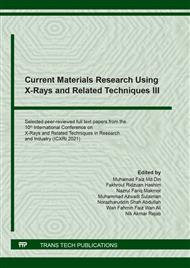[1]
B.Kilic, Produce of carbon nanotube/ZnO nanowires hybrid photoelectrode for efficient dye-sensitized solar cells. Journal of Materials Science: Materials in Electronics, 30(4), 3482-3487, (2019).
DOI: 10.1007/s10854-018-00624-y
Google Scholar
[2]
W. J.Lin, C. T. Hsu, Y. C. Tsai, Dye-sensitized solar cells based on multiwalled carbon nanotube–titania/titania bilayer structure photoelectrode. Journal of colloid and interface science, 358(2), 562-566, (2011).
DOI: 10.1016/j.jcis.2011.03.031
Google Scholar
[3]
R.Riaz, M.Ali, T.Maiyalagan, A. S.Anjum, S.Lee, Dye-sensitized solar cell (DSSC) coated with energy down shift layer of nitrogen-doped carbon quantum dots (N-CQDs) for enhanced current density and stability. Applied Surface Science, 483, 425-431, (2019).
DOI: 10.1016/j.apsusc.2019.03.236
Google Scholar
[4]
X. Fang, Graphene quantum dots optimization of dye-sensitized solar cells,,Electrochim. Acta, vol. 137, p.634–638, (2014).
DOI: 10.1016/j.electacta.2014.06.075
Google Scholar
[5]
S. Muthulingam, I. H. Lee, P. Uthirakumar, Highly efficient degradation of dyes by carbon quantum dots/N-doped zinc oxide (CQD/N-ZnO) photocatalyst and its compatibility on three different commercial dyes under daylight. Journal of colloid and interface science, 455, 101-109, (2015).
DOI: 10.1016/j.jcis.2015.05.046
Google Scholar
[6]
D.Wang, I. S.Cole, Q.Li, Quantum-confined band gap narrowing of TiO 2 nanoparticles by graphene quantum dots for visible-light-driven applications. Chemical Communications, 52(59), 9208-9211, (2016).
DOI: 10.1039/c6cc03302d
Google Scholar
[7]
I. Mihalache, Charge and energy transfer interplay in hybrid sensitized solar cells mediated by graphene quantum dots. Electrochima Acta ;153:306–15, (2015).
DOI: 10.1016/j.electacta.2014.11.200
Google Scholar
[8]
N. F. M.Sharif, M. Z. A. A.Kadir, S.Shafie, S. A. Rashid, W. W.Hasan, S. Shaban, Charge transport and electron recombination suppression in dye-sensitized solar cells using graphene quantum dots. Results in Physics, 13, 102171, (2019).
DOI: 10.1016/j.rinp.2019.102171
Google Scholar
[9]
D.Sinha, D.De, A.Ayaz, Performance and stability analysis of curcumin dye as a photo sensitizer used in nanostructured ZnO based DSSC. Spectrochimica Acta Part A: Molecular and Biomolecular Spectroscopy, 193, 467-474, (2018).
DOI: 10.1016/j.saa.2017.12.058
Google Scholar
[10]
B.S. Razbirin, N.N. Rozhkova, Fractals of graphene quantum dots in photoluminescence solar cells. J Exp Theor Phys;118(5):735–46 , (2014).
DOI: 10.1134/s1063776114050161
Google Scholar
[11]
H.Chen, W. Li, H.Liu, L.Zhu, CdS quantum dots sensitized single-and multi-layer porous ZnO nanosheets for quantum dots-sensitized solar cells. Electrochemistry Communications, 13(4), 331-334, (2011).
DOI: 10.1016/j.elecom.2011.01.017
Google Scholar
[12]
N.F.M. Sharif, M.Z.A.A. Kadir, TiO2 Thickness and Graphene Quantum Dots variation in photoelectrode of Dye Sensitised solar cell using Response Surface Methodology (RSM) technique.,, Solid State Sci. Technol., vol. 26, no. 2, p.43–49, (2018).
Google Scholar
[13]
S. Yu, Y. Q.Zhong, B.Q.Yu, S. Y.Cai, L. Z.Wu, Y. Zhou, Graphene quantum dots to enhance the photocatalytic hydrogen eVolution efficiency of anatase TiO 2 with exposed {001} facet. Physical Chemistry Chemical Physics, 18(30), 20338-20344, (2016).
DOI: 10.1039/c6cp02561g
Google Scholar
[14]
Z.Salam, E. Vijayakumar, A.Subramania, N.Sivasankar, S. Mallick, Graphene quantum dots decorated electrospun TiO2 nanofibers as an effective photoanode for dye sensitized solar cells. Solar Energy Materials and Solar Cells, 143, 250-259, (2015).
DOI: 10.1016/j.solmat.2015.07.001
Google Scholar
[15]
F.Scarpelli, T. F.Mastropietro, T.Poerio, N.Godbert, Mesoporous TiO2 thin films: State of the art. Titanium Dioxide-Material for a Sustainable Environment, 508, (2018).
DOI: 10.5772/intechopen.74244
Google Scholar
[16]
R.Xie, L.Zhang, H. Xu, Y Zhong, X. Sui, Z.Mao, Construction of up-converting fluorescent carbon quantum dots/Bi20TiO32 composites with enhanced photocatalytic properties under visible light. Chemical Engineering Journal, 310, 79-90, (2017).
DOI: 10.1016/j.cej.2016.10.089
Google Scholar
[17]
Z.Golnoush, Preparation of graphene quantum dots as a green photosensitizer and its application in Dye sensitized solar cell, Doctoral Thesis (2018).
Google Scholar


